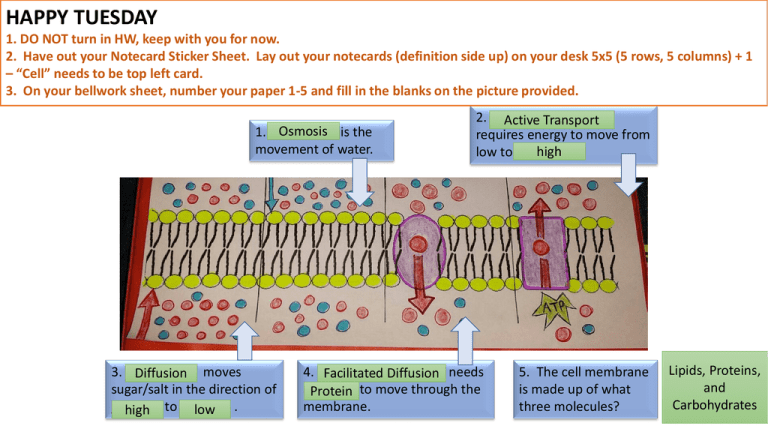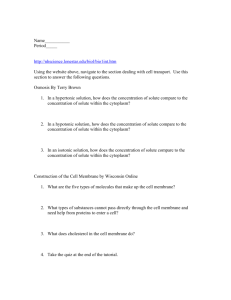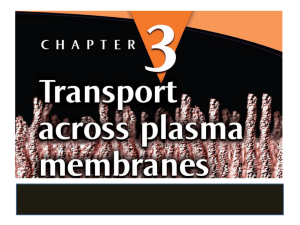Review PowerPoint
advertisement

HAPPY TUESDAY 1. DO NOT turn in HW, keep with you for now. 2. Have out your Notecard Sticker Sheet. Lay out your notecards (definition side up) on your desk 5x5 (5 rows, 5 columns) + 1 – “Cell” needs to be top left card. 3. On your bellwork sheet, number your paper 1-5 and fill in the blanks on the picture provided. Osmosis is the 1. _________ movement of water. 3. _________ Diffusion moves sugar/salt in the direction of _______ low . high to _______ 2. _______ ________ Active Transport requires energy to move from high low to ______ 4. ________ ________ needs Facilitated Diffusion aProtein ______ to move through the membrane. 5. The cell membrane is made up of what three molecules? Lipids, Proteins, and Carbohydrates Microscope Practice Test TOMORROW! • What to study: • Prokaryote vs Eukaryote • Cell Theory • Endosymbiotic Theory • Cell membrane (parts & functions) • Hypertonic, Hypotonic, Isotonic • Molecule Transport (Osmosis, Diffusion, Facilitated Diffusion, Active Transport) • Egg Lab • Microscope Lab Essential Question PG 38 What should I do to better prepare myself for the cell/molecule transport test? Standard B.4B – Investigate and explain cellular processes, including homeostasis, energy conversions, transport of molecules, and synthesis of new molecules 1) Inside one osmosis bag, A, is a 50% glucose solution and inside bag B is a 20% glucose solution. Both bags are put into beakers containing 100% water. A) Bag A will gain weight. B) Bag B will gain weight. C) Both bags will gain weight. D) Both bags will loose weight. E) Both bags will remain the same. a 50% solute 0% solute b 20% solute 0% solute 1) Inside one osmosis bag, A, is a 50% glucose solution and inside bag B is a 20% glucose solution. Both bags are put into beakers containing 100% water. A) Bag A will gain weight. B) Bag B will gain weight. C) Both bags will gain weight. D) Both bags will loose weight. E) Both bags will remain the same. a 50% solute 0% solute b 20% solute 0% solute 2) A 0.9% NaCl solution is isotonic to red blood cells. Which of these describes the results if red blood cells are placed into a 9% solution of NaCl? A) They will burst. B) They will shrink. C) Nothing will happen. D) They will expand but not burst. E) None of the above. 0.9% solute 9% solute 0.9% solute 0.9% solute 2) A 0.9% NaCl solution is isotonic to red blood cells. Which of these describes the results if red blood cells are placed into a 9% solution of NaCl? A) They will burst. B) They will shrink. C) Nothing will happen. D) They will expand but not burst. E) None of the above. 0.9% solute 9% solute 0.9% solute 0.9% solute 3) The U-shaped tube in the figure below is divided by a membrane that is impermeable to starch but permeable to water. Which of the following will occur? A) Water will move from the right to the left. B) Water will move from the left to the right. C) Starch will move from the right to the left. D) Starch will move from the left to the right. E) Nothing will happen. The membrane blocks the passage of all the molecules. 3) The U-shaped tube in the figure below is divided by a membrane that is impermeable to starch but permeable to water. Which of the following will occur? A) Water will move from the right to the left. B) Water will move from the left to the right. C) Starch will move from the right to the left. D) Starch will move from the left to the right. E) Nothing will happen. The membrane blocks the passage of all the molecules. 4) Wallaway is a new general herbicide for aquatic plants. It is effective against freshwater but not saltwater plants. It works by breaking down the cell walls of the plants. The freshwater plants dies because their cells A) swell and burst. B) shrink and cease to function. C) remain the same size but malfunction. D) are crushed by the weight of the plant. freshwater a saltwater b hypotonic hypertonic 4) Wallaway is a new general herbicide for aquatic plants. It is effective against freshwater but not saltwater plants. It works by breaking down the cell walls of the plants. The freshwater plants dies because their cells A) swell and burst. B) shrink and cease to function. C) remain the same size but malfunction. D) are crushed by the weight of the plant. freshwater a saltwater b hypotonic hypertonic 5) A red blood cells has a salt concentration of 0.9%. What will happen if it is placed into a 0.8% salt solution? The red blood cell will A) shrink if its membrane is permeable to both the salt and the water. B) shrink if its membrane is impermeable to the salt and permeable to the water. C) maintain its shape, ie nothing will happen. D) swell and probably burst because its membrane is a 0.9% solute impermeable to salt and permeable to water. 0.8% solute E) swell and probably burst because its membrane is impermeable to water and permeable to salt. 5) A red blood cells has a salt concentration of 0.9%. What will happen if it is placed into a 0.8% salt solution? The red blood cell will A) shrink if its membrane is permeable to both the salt and the water. B) shrink if its membrane is impermeable to the salt and permeable to the water. C) maintain its shape, ie nothing will happen. D) swell and probably burst because its membrane is a 0.9% solute impermeable to salt and permeable to water. 0.8% solute E) swell and probably burst because its membrane is impermeable to water and permeable to salt. 6) Two beakers (below) are connected by a tube partitioned by a membrane permeable to water but not to protein. Which one of the following statements best describes what will happen to this system? A) Water will only move from A to B. B) Water will only move from B to A. C) Water will move equally in both directions so that there will be no net change in the system. D) Water will move in both directions, but the net flow will be from A to B. E) Water will move in both directions, but the net flow will be from B to A. 6) Two beakers (below) are connected by a tube partitioned by a membrane permeable to water but not to protein. Which one of the following statements best describes what will happen to this system? A) Water will only move from A to B. B) Water will only move from B to A. C) Water will move equally in both directions so that there will be no net change in the system. D) Water will move in both directions, but the net flow will be from A to B. E) Water will move in both directions, but the net flow will be from B to A. Molecule Transport Foldable PG 35 Step 1 – Color (Lipid Heads– Green, Lipid Tails – Blue, Proteins- Purple) Step 2 - With the Cell Membrane facing up, fold your paper in half (Hot Dog Style) Step 3 - Cut 3 slits on the segments ONLY on the half of the paper facing you. Step 4 - On the half facing up – Separate into 4 Segments and write the Diffusion, Osmosis, Facilitated Diffusion and Active Transport (in that order) – Create concrete spellings. PG 35 •Diffusion, Osmosis, Facilitated Diffusion, Active Transport •Does it use energy? •What’s moving? Water OR Solutes •Is it moving from High to Low OR Low to High? •Does it move through the Phospholipid Bilayer OR Protein Channel? SUGAR WATER ENERGY Direction of particles PG 35 PG 35 •Diffusion, Osmosis, Facilitated Diffusion, Active Transport •Does it use energy? •What’s moving? Water OR Solutes •Is it moving from High to Low OR Low to High? •Does it move through the Phospholipid Bilayer OR Protein Channel? SUGAR WATER ENERGY Direction of particles







